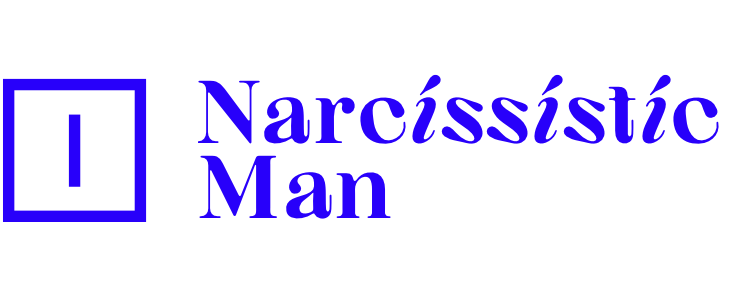Financial Recovery from Narcissistic Abuse
How to Withdraw From Your Retirement Plan
Leverage age requirements and strategic planning for penalty-free retirement withdrawals, ensuring financial security and tax optimization.

To withdraw from your retirement plan, consider age requirements for penalty-free access. Generally, reaching 59.5 allows penalty-free withdrawals from most 401(k)s, while some plans permit it at 55. Traditional IRAs may incur a 10% penalty if withdrawn before 59.5, but Roth IRAs have more flexibility. Strategic withdrawal planning is vital to avoid unnecessary penalties and taxes, influenced by your planned retirement age. Understanding rules like Required Minimum Distributions (RMDs) and upcoming legislative changes, such as the SECURE 2.0 Act, is essential for effective retirement planning and tax management. Managing retirement income wisely is key to sustaining financial security.
Key Takeaways
- Understand age requirements for penalty-free withdrawals.
- Consider early withdrawal penalties for IRAs before 59.5.
- Implement strategies for managing retirement income effectively.
- Be aware of the impact of SECURE 2.0 on RMD ages.
- Know the withdrawal rules for IRAs to avoid penalties and taxes.
Age Requirements for Penalty-Free Withdrawals
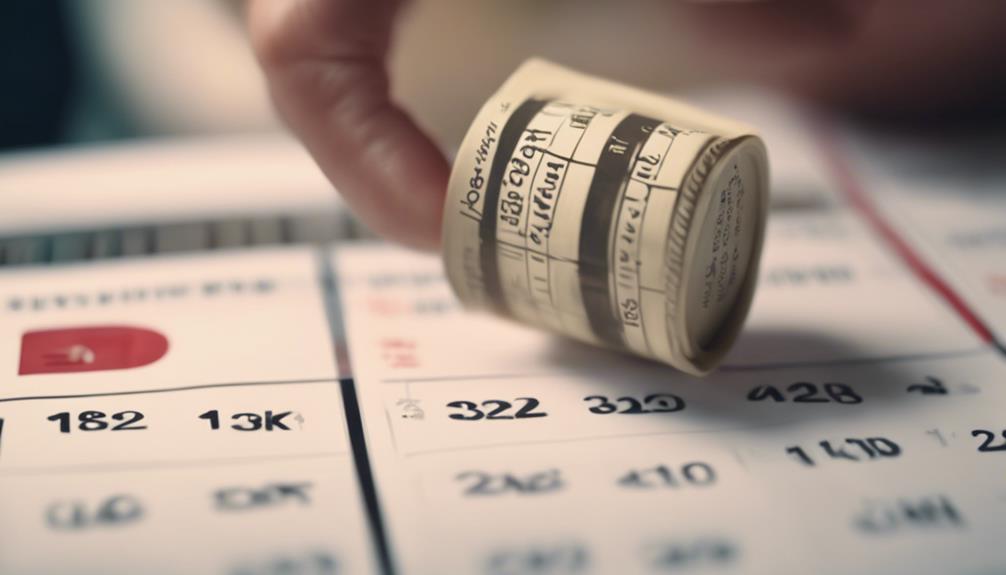
Understanding the age requirements for penalty-free withdrawals from retirement plans is essential for effective financial planning and avoiding unnecessary fees. In the domain of retirement accounts such as 401(k)s, reaching the age of 59.5 typically grants individuals the ability to make penalty-free withdrawals.
However, it is worth noting that some 401(k) plans may permit penalty-free withdrawals as early as age 55, offering a potential advantage for some retirees.
When it comes to traditional IRAs, withdrawals made before the age of 59.5 may incur a 10% penalty, making it vital for account holders to adhere to the age requirements to avoid unnecessary financial setbacks. On the other hand, Roth IRAs provide more flexibility in this regard, as they do not impose penalty-free withdrawal age restrictions.
This distinction underscores the importance of understanding the specific rules governing different types of retirement accounts to make informed decisions regarding withdrawals and financial planning strategies.
Early Withdrawal Penalties for IRAs

Early withdrawal penalties for IRAs can have significant financial implications for individuals who access their retirement funds before the age of 59.5. Withdrawals made before this age may incur a 10% tax penalty on top of regular income tax. It is important to note that planned withdrawals are essential to avoid unnecessary penalties and taxes.
However, there are exceptions to the 10% tax penalty for certain situations, such as using the funds for qualified higher education expenses or a first-time home purchase. Understanding the implications of withdrawing from an IRA before reaching the age of 59.5 is essential for effective retirement planning.
Factors like the individual's planned retirement age also play a role in determining the penalties associated with early withdrawals. Therefore, careful consideration and financial planning are necessary to minimize the impact of penalties and taxes when accessing retirement funds prematurely.
Strategies for Managing Retirement Income

When considering retirement planning, it becomes imperative to develop effective strategies for managing income during this phase of life. Adaptive withdrawal strategies allow for adjustments to income based on market conditions and personal needs, ensuring financial stability.
The 4% rule is a popular method for systematic withdrawals, providing a sustainable income stream while preserving the retirement nest egg. Fixed-dollar withdrawals offer predictability in income flow, ideal for those seeking stability during retirement.
On the other hand, fixed-percentage withdrawals, linked to portfolio value, help align income with investment performance, adjusting accordingly. Implementing a systematic withdrawal plan leverages investment income to manage cash flow effectively throughout retirement, offering a strategic approach to sustaining financial well-being.
Impact of SECURE 2.0 on RMD Ages

The recent enactment of the SECURE 2.0 Act has significant implications for retirement planning, particularly in relation to the adjustment of required minimum distribution (RMD) ages. Under this financial legislation, the age for commencing RMDs is set to increase to 73 starting in 2023, with a further increase to 75 by 2033.
These changes affect the timing of mandatory withdrawals from retirement accounts, shaping how individuals manage their money in retirement. Understanding the provisions of the SECURE 2.0 Act is vital for effective retirement planning, as it alters the age at which retirees must start withdrawing funds from their retirement accounts.
The adjustments in RMD ages introduced by this act aim to provide retirees with more flexibility in managing their savings, aligning with the evolving financial needs of individuals as they plan for retirement. Stay informed about these changes to make sure your retirement plan remains in line with current regulations and best practices in financial planning.
Withdrawal Rules for IRAs

When considering withdrawals from IRAs, it's vital to be aware of the age-related rules and potential penalties involved. Early withdrawals from Traditional IRAs before 59.5 years old can trigger a 10% penalty, while Roth IRAs have more flexibility but still require attention to avoid penalties on earnings.
Understanding Required Minimum Distributions (RMDs) and the specific rules for Inherited IRAs based on beneficiary relationships is essential for making informed decisions about IRA withdrawals.
IRA Withdrawal Age
Upon reaching the age of 59.5, individuals can initiate penalty-free withdrawals from their Traditional and Roth IRAs. Traditional IRAs necessitate starting Required Minimum Distributions (RMDs) at age 72, while Roth IRAs do not have RMD requirements during the account owner's lifetime.
Early withdrawals from IRAs before age 59.5 may incur a 10% tax penalty. The upcoming SECURE Act 2.0 will elevate the age for commencing RMDs to 73 in 2023 and further to 75 in 2033. Understanding these age-related rules is essential for proper retirement planning and tax management.
It is advisable for individuals to take into account these milestones to make informed decisions regarding their retirement savings and withdrawals.
IRA Withdrawal Penalties
Reaching the age of 59.5 marks an important milestone for individuals with Traditional and Roth IRAs, impacting the penalty-free withdrawal options available to them. Early withdrawal from an IRA before this age may result in a 10% penalty, except in cases such as first-time home purchases, higher education expenses, or certain medical expenses.
Traditional IRAs have required minimum distributions (RMDs) that begin at age 72, whereas Roth IRAs do not have RMD requirements during the account owner's lifetime. Understanding these penalty implications and exceptions is essential to optimizing retirement savings strategies and avoiding unnecessary financial setbacks.
Withdrawal Order for Retirement Accounts
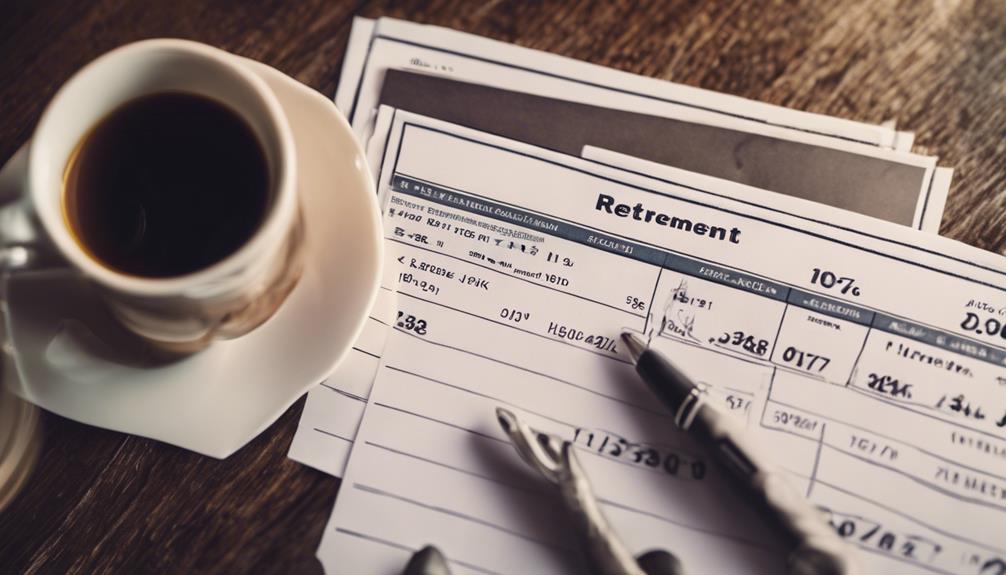
Understanding the withdrawal order for retirement accounts is essential for managing your finances effectively.
Beginning with required minimum distributions (RMDs) and progressing to penalty-free withdrawals, knowing the sequence can optimize tax efficiency and growth.
Withdrawal Sequence Explanation
Commencing with the required minimum distributions (RMDs) for Traditional IRAs at age 72, the withdrawal sequence for retirement accounts strategically dictates the order in which funds are accessed to optimize financial outcomes.
Following RMDs, individuals can explore penalty-free withdrawals from 401(k) accounts starting at age 59.5.
Remarkably, Roth IRAs differ as they do not mandate RMDs during the account owner's lifetime.
Understanding the specific withdrawal rules and timelines for each type of retirement account is paramount for effective financial planning. Adhering to a strategic withdrawal sequence can greatly enhance tax efficiency and maximize retirement savings over the long term.
Account Closure Process
After strategically determining the withdrawal sequence for your retirement accounts to optimize financial outcomes, the next step involves initiating the closure process by submitting a withdrawal order. In this order, specify the amount you wish to withdraw from your retirement account and include any additional instructions necessary for the transaction.
It is important to follow the account closure process outlined by your retirement plan provider, ensuring that you provide all required documentation and information for the withdrawal to be processed smoothly. Be mindful of any associated fees, taxes, or penalties that may apply to the withdrawal from your retirement plan, as these factors can impact the final amount you receive.
Tax Implications Overview
When considering withdrawals from retirement accounts, it is important to understand the tax implications associated with different types of accounts. Withdrawals from traditional IRAs and 401(k)s are subject to income tax at your marginal tax rate, while Roth IRA withdrawals can be tax-free under specific conditions.
Early withdrawals from traditional IRAs or 401(k)s before age 59.5 may incur a 10% penalty in addition to income tax. Required Minimum Distributions (RMDs) starting at age 72 for traditional IRAs and 401(k)s can impact tax planning strategies.
A strategic withdrawal order can optimize tax efficiency by considering the various tax treatments of different retirement accounts. Planning ahead and understanding these tax implications can help individuals make informed decisions about their retirement savings.
Considerations for Roth Conversions
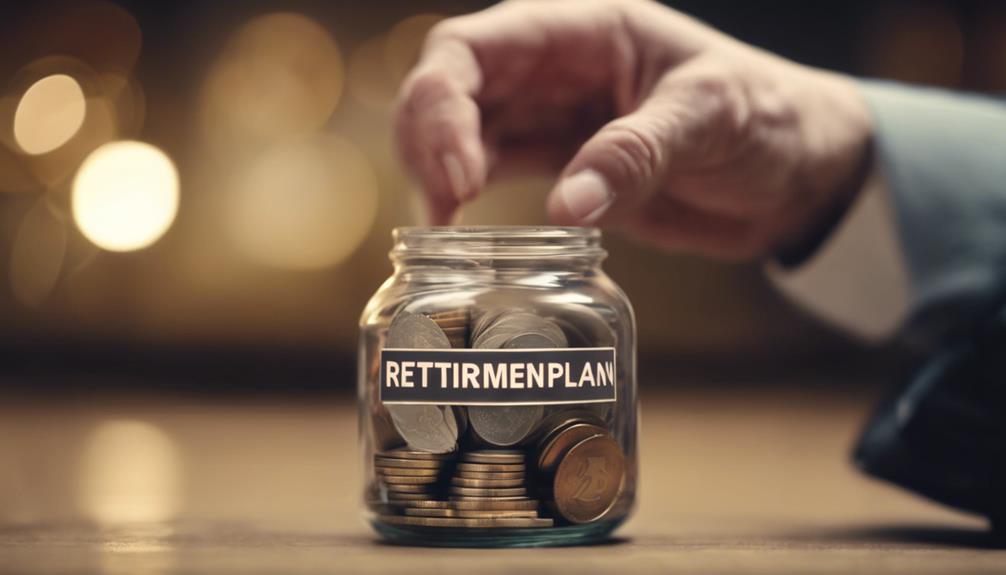
Considering Roth conversions as a strategic maneuver for tax planning in retirement can offer significant benefits for individuals with traditional retirement accounts. When contemplating Roth conversions, there are several essential considerations to keep in mind:
- Tax-Free Withdrawals: While taxes are paid on the converted amount initially, future withdrawals from a Roth IRA are tax-free, potentially saving you money in the long run.
- Managing Tax Liabilities: Roth conversions can be a strategic tool for managing tax liabilities in retirement, allowing you to control when and how you pay taxes on your retirement savings.
- Lower Income Years: Converting to a Roth IRA during lower income years can help minimize the tax impact, as you may be in a lower tax bracket, reducing the amount of taxes owed on the conversion.
- Consult a Financial Advisor: It is important to consult with a financial advisor to assess if Roth conversions align with your financial goals and overall retirement plan, ensuring that this strategic move benefits your long-term financial well-being.
Frequently Asked Questions
How Do I Withdraw Money From My Retirement Plan?
To withdraw money from your retirement plan, make sure you meet the age requirements to avoid penalties. Consider hardship withdrawals for urgent financial needs or explore 401(k) loans within set limits and repayment terms.
Early withdrawals before age 59.5 may incur penalties and taxes, so weigh your options carefully. Consult with a financial advisor for personalized guidance on the most suitable withdrawal strategy aligned with your retirement goals and financial situation.
Can I Pull My Retirement Money Out Whenever I Want?
While the flexibility to access retirement funds may seem appealing, withdrawing money whenever desired can incur penalties and tax implications. Early withdrawals typically trigger penalties, with exceptions for certain hardships.
Roth IRAs offer more leniency, allowing penalty-free withdrawals of contributions in many cases. Understanding the rules surrounding retirement plan withdrawals is essential for effective financial planning and avoiding unnecessary penalties.
Can I Close My 401K and Take the Money?
Closing your 401(k) and taking the money prematurely can trigger penalties and taxes. Early withdrawal before age 59.5 may result in a 10% penalty. It's important to evaluate the long-term impact on your retirement savings and financial security.
Exploring alternatives like hardship withdrawals or loans is advisable. Consulting with a financial advisor is recommended to fully comprehend the consequences and to explore other viable options before making a decision.
Can a Retirement Plan Be Cashed Out?
A retirement plan can be cashed out, but such a decision may trigger taxes, penalties, and potential loss of future growth.
Early withdrawal before age 59.5 could result in a 10% penalty along with regular income taxes.
Hardship withdrawals are available for immediate financial needs, limited to the amount required to address the hardship.
It is advisable to explore alternatives like loans or partial withdrawals first.
Consult a financial advisor to fully grasp the implications of cashing out a retirement plan.
Conclusion
In summary, withdrawing from your retirement plan requires careful consideration and adherence to specific rules and regulations. Planning ahead and understanding the age requirements, penalties, and strategies for managing retirement income are essential.
It is important to approach withdrawals with caution, like an experienced guide steering through treacherous waters, to guarantee financial stability and security in your retirement years.
As our Lead Writer, Mia has a talent for turning complex ideas into compelling narratives. With a rich background in writing and a deep passion for psychology, Mia’s articles provide insightful, accessible explorations of narcissistic behavior and its impact on individuals and relationships. Mia’s contributions are thought-provoking and offer practical advice for our readers.
Financial Recovery from Narcissistic Abuse
How to Invest Retirement Funds in Gold Through Your 403B
Navigate the intricate process of investing retirement funds in gold through your 403B, uncovering valuable strategies for financial success.

To invest retirement funds in gold through your 403B, start by choosing a specialized IRA custodian. Coordinate with your 403B administrator for fund transfer approval and follow IRS regulations for a smooth rollover. Verify compliance and monitor your gold investments in the portfolio. Align your investments with financial goals by seeking advice from a financial advisor to optimize long-term objectives. Consider factors like risk and returns, reacting promptly to market shifts for effective retirement planning. Enhance diversification in your retirement account strategically. Learn about the benefits of including gold in your portfolio for a well-rounded investment strategy.
Key Takeaways
- Understand 403(b) plan rules on gold investment.
- Coordinate with administrator for fund transfer approval.
- Choose a reputable Gold IRA custodian.
- Initiate direct rollover to invest in gold.
- Diversify retirement portfolio for risk management.
Researching and Selecting a Custodian

When investing retirement funds in gold through your 403B, the initial essential step is researching and selecting a custodian with expertise in handling precious metals investments. A reputable IRA custodian specializing in Gold IRAs should be chosen, ensuring they offer secure storage options in IRS-approved depositories.
It is important to check for accreditations like Better Business Bureau ratings and TrustLink reviews to assess the custodian's credibility. Evaluating custodian fees, customer support, and services is necessary to make an informed decision.
Additionally, researching custodian performance through customer testimonials and independent reviews can provide insights into their reputation. By conducting thorough due diligence, investors can select a custodian that aligns with their investment goals and preferences, providing peace of mind regarding the safety and management of their precious metals investments.
Coordinating With 403B Administrator

When coordinating with your 403(b) administrator, it is essential to reach out to inquire about plan guidelines regarding the transfer of funds to a Gold IRA. Understanding these guidelines will help you navigate the process smoothly and efficiently.
Additionally, seeking investment approval from the administrator is important to guarantee compliance with all necessary regulations and procedures.
Contacting 403B Administrator
To facilitate the process of transferring retirement funds for investing in gold, it is essential to promptly reach out to your 403(b) administrator and collaborate closely to navigate the necessary steps and requirements.
Contacting your 403(b) administrator is the initial step in the investment process towards gold investments. By engaging with the administrator, you can gain valuable insights into the rollover process to a Gold IRA or a self-directed IRA.
Clear communication is key to understanding any specific documentation requirements and rules governing the transfer of funds. Working hand in hand with the 403(b) administrator guarantees a smooth handover of your retirement funds into a Gold IRA for potential gold investments.
Understanding Plan Guidelines
After establishing contact with your 403(b) administrator regarding the process of transferring retirement funds for investing in gold, the next step involves thoroughly understanding the plan guidelines in coordination with the administrator.
Review the specific guidelines of your 403(b) plan to grasp any restrictions or limitations on investing in gold. Coordinate with your administrator to guarantee compliance with plan rules when considering gold investments. Seek clarification on any documentation or approval requirements before proceeding.
Understand the fees and administrative processes involved when coordinating your gold investment with your 403(b) plan. Confirm that your 403(b) plan allows transfers or rollovers to a self-directed IRA for gold investments. It is essential to be well-versed in these aspects to make informed decisions about your retirement investments.
Seeking Investment Approval
In the process of seeking investment approval for directing retirement funds towards gold within your 403(b) plan, close coordination with the plan administrator is vital. This guarantees compliance with plan-specific rules regarding alternative investments like gold. Provide the necessary documentation and information for the approval process, and obtain written authorization before proceeding with a gold IRA account or rollover. It is important to clarify any associated fees, penalties, or procedures related to transferring funds from the 403(b) plan to a gold investment account. By following these steps and working closely with the 403(b) plan administrator, you can navigate the approval process smoothly and securely initiate investments in gold.
| Key Considerations | Actions | Significance |
|---|---|---|
| Documentation | Provide necessary paperwork | Ensures compliance |
| Authorization | Obtain written approval | Securely proceed with investments |
| Fees & Penalties | Clarify associated costs | Understand financial implications |
| Compliance | Follow plan-specific rules | Adhere to investment guidelines |
Initiating Direct Rollover of Funds
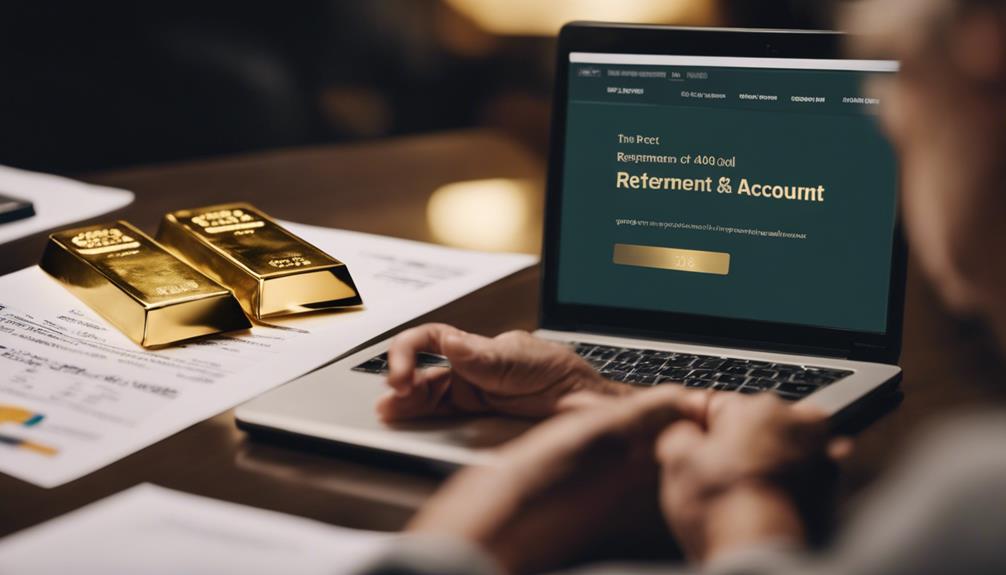
The process of initiating a direct rollover of funds from a 403(b) account to a Gold IRA involves transferring retirement savings directly to the IRA custodian. This direct rollover method offers a tax-advantaged method to invest in precious metals like gold, silver, platinum, or palladium.
By choosing a direct rollover, investors can avoid potential taxes and penalties associated with indirect rollovers. It is important to follow IRS regulations and guidelines during this process to guarantee compliance and maintain the tax-advantaged status of the retirement savings.
The funds transferred to the Gold IRA custodian are then available for investment in approved precious metals, providing a diversified investment strategy within a retirement account. Opting for a direct rollover simplifies the transfer of funds and aligns with regulatory requirements, making it a recommended choice for those looking to leverage the benefits of investing in precious metals through a retirement account.
Ensuring Compliance With IRS Regulations
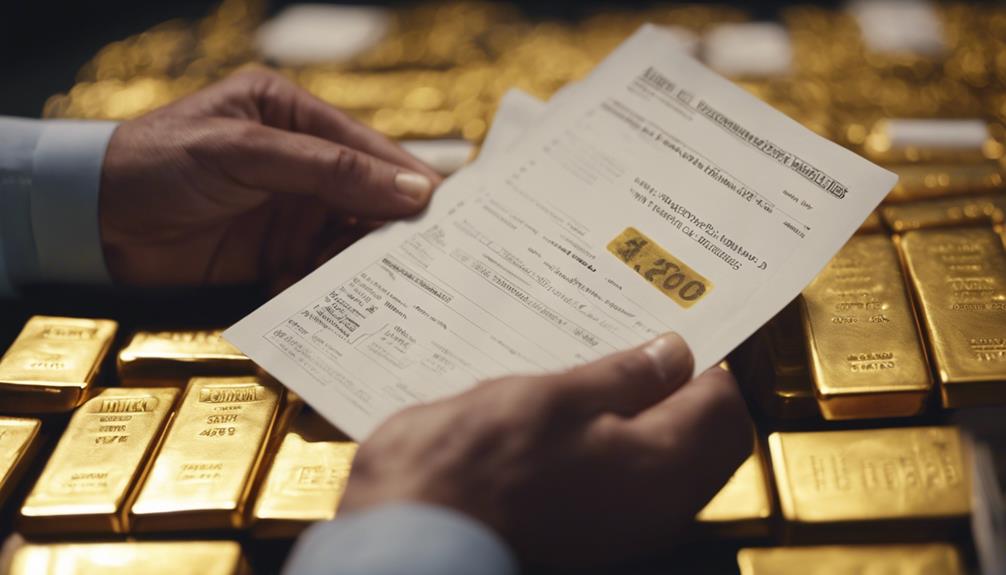
To guarantee compliance with IRS regulations when investing retirement funds in gold through your 403(b), it is vital to understand the IRS compliance requirements and reporting obligations.
These regulations clarify the standards for purity levels of approved precious metals within the plan. Using IRS-approved depositories for storing the gold is essential to meet regulatory guidelines and maintain the tax-advantaged status of your retirement savings.
IRS Compliance Requirements
What are the specific fineness standards that precious metals held in a Gold IRA must meet to comply with IRS regulations?
Precious metals in a Gold IRA are required to meet precise fineness standards as mandated by the IRS. Approved metals for IRA investments, including gold, silver, platinum, and palladium, must adhere to these standards to guarantee compliance with IRS regulations.
The IRS-approved depositories play an essential role in securely storing physical metals, maintaining compliance with IRS guidelines for precious metal IRAs. Adhering to IRS regulations is critical to avoid penalties and retain the tax benefits associated with Gold IRAs.
Understanding and meeting IRS requirements regarding precious metals in retirement accounts is fundamental for a successful and compliant investment strategy.
Reporting Obligations Clarified
Upon investing retirement funds in gold through a 403(b), meticulous attention to reporting obligations is essential to guarantee complete compliance with IRS regulations.
Properly document gold investments in your 403(b) to ensure regulatory compliance.
Accurately report gold holdings in your retirement account for tax purposes.
Understand the reporting obligations associated with holding gold in a 403(b).
Compliance with IRS rules on reporting gold investments in a 403(b) is critical to avoid penalties or issues.
Monitoring Gold Investments in Portfolio
Regularly evaluating the performance of gold investments within your 403(b) portfolio is crucial for tracking growth and staying attuned to market trends. Monitoring the value of your gold holdings allows you to make informed decisions regarding adjustments or rebalancing.
Stay updated on economic indicators and global events that could impact the price of gold in your retirement portfolio. Diversifying your gold investments within your 403(b) can help spread risk and optimize returns.
Consulting with a financial advisor is advisable to analyze the performance of your gold investments in relation to your overall retirement goals and risk tolerance. By keeping a close eye on how your gold investments are faring, you can react promptly to market shifts and make sure that your retirement funds are working effectively for your future financial security.
Stay informed, stay proactive, and stay on top of your gold investments within your retirement portfolio.
Aligning Investments With Financial Goals
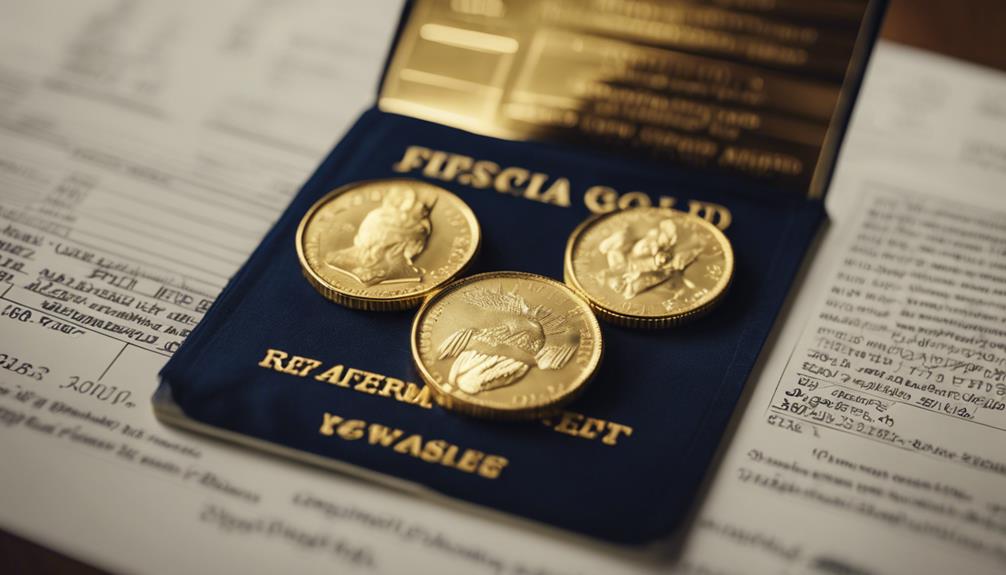
To guarantee the effective alignment of your investments with your financial goals, it is imperative to evaluate how investing retirement funds in gold through your 403(b) can strategically support your long-term objectives.
- Determine your financial goals for retirement, such as wealth preservation, diversification, or protection against market volatility.
- Assess the potential benefits of adding gold to your retirement portfolio, including stability, value retention, and hedging against economic uncertainties.
- Explore how gold investments can complement your existing 403(b) holdings to create a balanced and diversified retirement strategy.
- Consult with a financial advisor to evaluate how investing retirement funds in gold through your 403(b) can support your overall financial plan and retirement goals.
Frequently Asked Questions
How Do I Convert My 403B to Gold?
To convert your 403(b) to gold, follow these steps:
- Open a self-directed IRA and roll over funds from your 403(b) into the IRA.
- Choose gold assets and securely store them in an IRS-approved depository.
- Seek guidance from a Precious Metals Specialist for effective conversion.
- Adhere to IRS guidelines on gold purity requirements when holding gold in a Gold IRA.
- Consider tax implications, especially if converting from a traditional 403(b) to a Roth Gold IRA.
What Is the Best Way to Invest in Gold for Retirement?
When considering investing in gold for retirement, it is essential to evaluate various options such as self-directed Gold IRAs that allow for physical gold investments. Research IRS-approved gold bullion coins, silver, platinum, or palladium for diversification.
Select a reputable Gold IRA provider for secure storage and diverse metal choices. Regularly review and adjust investments to align with market conditions. Seek guidance from financial advisors to make informed decisions on diversifying retirement funds with gold investments.
How Do I Avoid Taxes on My 403B Withdrawal?
To avoid taxes on your 403(b) withdrawal, consider a direct rollover into a Gold IRA. This method typically allows for tax-free transactions and avoids penalties.
Indirect rollovers, where funds are received before transferring to a Gold IRA, may incur taxes and penalties if not completed within 60 days.
Consulting with a tax professional is essential to guarantee compliance with IRS regulations and maximize tax benefits on your 403(b) to Gold IRA rollover.
Can I Use My 403B to Invest?
Yes, you can use your 403(b) to invest in approved assets, including Gold ETFs, within the plan's guidelines.
It is important to evaluate the investment objectives, risks, and potential tax implications before adding gold investments to your retirement account.
Consulting with a retirement investment specialist can provide valuable insights on incorporating gold investments into your 403(b) plan strategically.
Make informed decisions based on your financial goals and risk tolerance.
Conclusion
To sum up, investing retirement funds in gold through your 403b requires careful research, coordination, compliance, monitoring, and alignment with financial goals.
By selecting a custodian, coordinating with your 403b administrator, initiating direct rollover of funds, ensuring IRS regulations compliance, and monitoring gold investments in your portfolio, you can make informed decisions to secure your financial future.
Remember to stay informed and proactive to maximize your investment potential and protect your retirement savings.
As our Lead Writer, Mia has a talent for turning complex ideas into compelling narratives. With a rich background in writing and a deep passion for psychology, Mia’s articles provide insightful, accessible explorations of narcissistic behavior and its impact on individuals and relationships. Mia’s contributions are thought-provoking and offer practical advice for our readers.
Financial Recovery from Narcissistic Abuse
How to Maximize Your Bitcoin IRA Contribution Limits
Leverage strategies to maximize Bitcoin IRA contributions for tax benefits and retirement savings, ensuring long-term success.

To maximize your Bitcoin IRA contribution limits, consider these strategies for optimizing tax benefits and retirement savings. Start by understanding the current limits (e.g., $7,000 for under 50 and $8,000 for 50+) and the importance of adherence. Utilize catch-up contributions for older investors, contribute consistently, and leverage Bitcoin's growth potential. Take advantage of tax benefits with tax-deferred or tax-free growth, and explore efficient growth opportunities by diversifying with cryptocurrencies. Long-term holding of Bitcoin within your IRA could compound growth potential and enhance your retirement savings. Make informed decisions to optimize your contributions for long-term success in your Bitcoin IRA.
Key Takeaways
- Plan strategically and invest consistently.
- Utilize catch-up contributions for older investors.
- Contribute steadily throughout the year.
- Maximize contributions for growth potential.
- Leverage tax benefits of Bitcoin IRAs.
Understanding Bitcoin IRA Contribution Limits

Understanding Bitcoin IRA contribution limits is vital for effectively managing your retirement savings and maximizing tax benefits.
For the year 2024, the contribution limits for a Bitcoin IRA stand at $7,000 for individuals under 50 and $8,000 for those aged 50 and above. These limits are applicable to both Traditional and Roth IRAs that include Bitcoin in their portfolios.
It is important to note that contributions to a Bitcoin IRA can be made until the tax filing deadline, usually falling on April 15 of the subsequent year. Adhering to these contribution limits is not only a regulatory requirement but also a strategic move to optimize the tax benefits and enhance retirement savings within the Bitcoin IRA.
Strategies for Maximizing Contributions

To optimize your Bitcoin IRA contributions effectively, strategic planning and consistent investment are key components for maximizing your retirement savings potential. With contribution limits set at $7,000 for individuals under 50 and $8,000 for those 50 and older, it's important to leverage catch-up contributions of an additional $1,000 for older investors to reach the maximum allowable amount.
By contributing steadily throughout the year, you can guarantee that you make the most of these limits. This approach not only helps you maximize your contributions but also allows you to take advantage of potential growth and tax benefits associated with Bitcoin IRAs.
Understanding the IRS limits and deadlines is essential for effective planning, ensuring that you stay within the boundaries while optimizing your retirement savings. By implementing these strategies and staying informed about the contribution limits, you can work towards building a robust Bitcoin IRA portfolio that aligns with your long-term financial goals.
Tax Benefits of Bitcoin IRAs

Bitcoin IRAs offer significant tax benefits, including tax-deferred or tax-free growth on investments and tax advantages upon withdrawal. Profits from selling Bitcoin in a Roth IRA are generally not taxable, making it an attractive option for retirement savings due to potential tax savings.
Utilizing a Bitcoin IRA can provide a tax-efficient strategy to grow retirement savings while maximizing contributions.
Tax Advantages Explained
An essential point to consider is that tax benefits within Bitcoin IRAs encompass advantageous provisions that foster tax-efficient growth and withdrawals for investors. One significant advantage is seen in Roth IRAs, where profits from selling crypto are generally not taxable, offering a substantial long-term tax benefit.
Additionally, funds in a Roth IRA can be withdrawn tax-free once the investor reaches age 59 ½, further enhancing the tax advantages of a Bitcoin IRA. It should be highlighted that tax assumptions include a federal long-term capital gains rate of 20% and a state tax rate of 5% on gains.
Early access to funds from a Bitcoin IRA may result in taxes and a 10% penalty, underscoring the importance of maintaining a long-term investment strategy to maximize the tax benefits.
Benefits of Bitcoin IRAs
Amidst the financial landscape, Bitcoin IRAs present a compelling solution for investors seeking to optimize their retirement savings through strategic tax planning. Bitcoin IRAs offer tax benefits that include tax-deferred or tax-free growth on investments, making them an attractive option for those looking to maximize their gains.
Gains from selling Bitcoin in a Roth IRA are typically not subject to taxes, providing a significant advantage for investors. Additionally, funds held in a Roth IRA containing Bitcoin can be withdrawn tax-free once the investor reaches the age of 59 ½, further enhancing the appeal of this investment vehicle.
However, it is essential to note that early access to funds from a Bitcoin IRA may result in taxes and a 10% penalty. Overall, utilizing a Bitcoin IRA can help individuals effectively manage their tax liabilities and potentially grow their retirement savings more efficiently.
Investing in Cryptocurrencies for Retirement

Exploring the potential for long-term financial growth through diversified retirement portfolios includes considering investments in cryptocurrencies. When it comes to investing in cryptocurrencies for retirement, there are several key points to keep in mind:
- Tax Advantages: Investing in cryptocurrencies through a Bitcoin IRA can provide tax advantages, allowing your retirement savings to grow more efficiently.
- Diversification: Including cryptocurrencies in your retirement portfolio can offer diversification beyond traditional assets, potentially enhancing overall portfolio performance.
- Potential Growth Opportunities: Cryptocurrency investments have shown significant growth potential over the years, offering the possibility of substantial returns for retirement savings.
- Risk Management: While cryptocurrencies can be volatile, judiciously adding them to a retirement portfolio can help manage risk by introducing uncorrelated assets.
Importance of Consistent Contributions

When considering investments in cryptocurrencies for retirement, one key aspect to focus on is the importance of consistent contributions to your Bitcoin IRA. Making regular contributions to your Bitcoin IRA can greatly impact your long-term growth potential.
By consistently investing in your Bitcoin IRA, you can take advantage of compound interest and dollar-cost averaging, which can enhance your overall returns over time. Setting up automatic contributions can help you maintain a disciplined approach to saving for retirement, ensuring that you contribute regularly without fail.
Additionally, by contributing consistently, you can benefit from potential market fluctuations over time, maximizing the growth of your retirement savings. Maximizing your Bitcoin IRA contributions through regular deposits is a strategic way to enhance your retirement savings strategy and work towards achieving your financial goals in the future.
Planning for Long-Term Growth
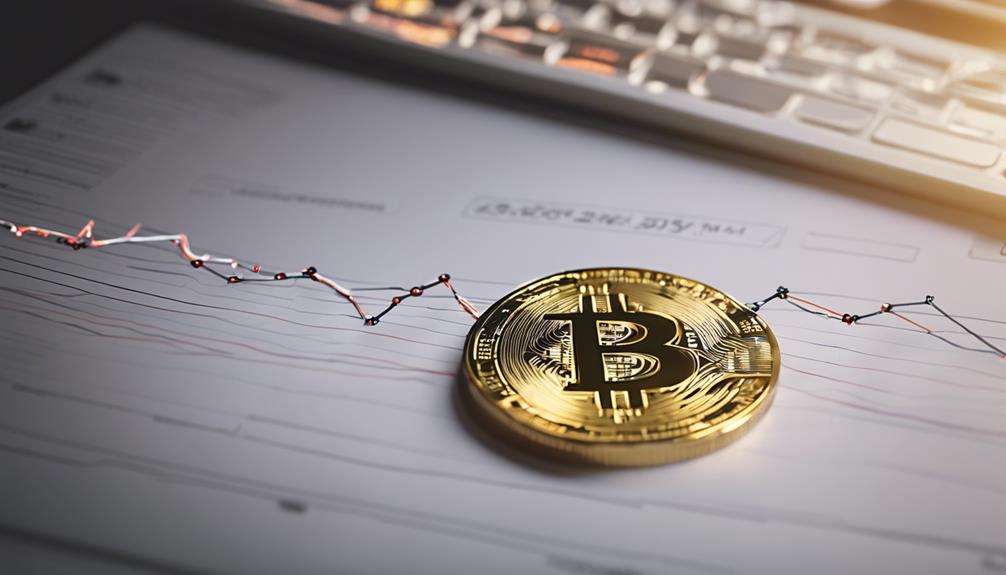
To guarantee long-term growth in your Bitcoin IRA, it is vital to strategize your investments and consider your time horizon.
By carefully planning your growth strategy and aligning it with your investment goals, you can make informed decisions that maximize your retirement savings potential.
Understanding the importance of a long-term perspective can help you navigate market fluctuations and optimize your financial outcomes in the future.
Growth Strategy Tips
Considering the dynamic nature of the cryptocurrency market, developing a strategic plan for long-term growth within your Bitcoin IRA is essential. To optimize growth potential and manage risk effectively, consider the following growth strategy tips:
- Utilize Dollar-Cost Averaging: Invest consistently over time to benefit from market fluctuations.
- Diversify Your Bitcoin Holdings: Spread your investments across different assets within your IRA.
- Evaluate Performance: Compare Bitcoin's long-term performance to traditional assets for informed decisions.
- Regularly Review and Adjust: Align your investment strategy with long-term financial goals by monitoring and adapting as needed.
Seeking guidance from financial professionals can help create a thorough growth strategy tailored to your Bitcoin IRA.
Investment Time Horizon
As you aim to maximize your Bitcoin IRA contribution limits for long-term growth, understanding the significance of your investment time horizon is essential. When planning for the future, especially with digital assets like Bitcoin, considering how long you intend to hold your investments within your IRA is vital.
Longer time horizons offer the potential for compounding growth, allowing your Bitcoin holdings to appreciate over time. By recognizing the benefits of holding Bitcoin for the long term, you can make well-informed decisions regarding your IRA contributions.
Strategically focusing on the long-term potential of Bitcoin within your IRA enables you to optimize your contribution limits, positioning yourself for maximum growth as the digital asset continues to evolve in the financial landscape.
Frequently Asked Questions
How Do I Max Out My IRA Contribution?
To maximize your IRA contribution, make sure you are aware of the annual contribution limits set by the IRS.
For individuals under 50, the maximum contribution for 2024 is $7,000, while those 50 and older can contribute up to $8,000, including a catch-up contribution.
By contributing the maximum allowable amount based on your age group, you can fully leverage the tax benefits and savings potential for your retirement.
Understanding these limits is important for optimizing your IRA contributions.
What Is the Limit for Bitcoin Ira?
The annual contribution limit for a Bitcoin IRA is $6,000 for individuals under 50 years old, with those aged 50 and above allowed an additional catch-up contribution of $1,000, raising their total limit to $7,000.
These limits apply to both traditional and Roth IRAs holding Bitcoin and are applicable across all IRAs owned by an individual.
Maximizing contributions to a Bitcoin IRA can boost long-term growth potential and offer tax advantages.
Is It a Good Idea to Have a Bitcoin Ira?
Investing in a Bitcoin IRA can be a prudent strategy for individuals seeking a diversified retirement portfolio with potential for high returns.
The tax advantages and long-term growth potential make a Bitcoin IRA a compelling option for those interested in the cryptocurrency market.
With inflation protection and the opportunity for compounding returns, a Bitcoin IRA can be a valuable addition to retirement planning, offering a unique asset class to enhance financial security in the future.
Is Bitcoin IRA Tax Deductible?
Bitcoin IRA contributions are not tax-deductible as they do not qualify for annual deductions. However, Roth IRAs, including Bitcoin Roth IRAs, offer tax-free benefits upon withdrawal.
Contributions to Bitcoin IRAs do not provide immediate tax deductions, but investing in Bitcoin through a Roth IRA can help individuals avoid paying taxes on gains.
Hence, while Bitcoin IRA contributions do not offer tax deductions, utilizing a Bitcoin Roth IRA can provide tax advantages upon withdrawal.
Conclusion
Ultimately, optimizing your Bitcoin IRA contribution limits is essential for long-term financial growth. By understanding the limits, implementing strategies to maximize contributions, and taking advantage of tax benefits, you can secure a stable retirement fund.
Consistent contributions and investing in cryptocurrencies wisely are key factors in ensuring your IRA grows over time. Make informed decisions and plan for the future to achieve your retirement goals effectively.
Remember, financial prudence today leads to prosperity tomorrow.
As our Lead Writer, Mia has a talent for turning complex ideas into compelling narratives. With a rich background in writing and a deep passion for psychology, Mia’s articles provide insightful, accessible explorations of narcissistic behavior and its impact on individuals and relationships. Mia’s contributions are thought-provoking and offer practical advice for our readers.
Financial Recovery from Narcissistic Abuse
Bitcoin IRA Custodian Services: A Guide to Securing Your Future
Harness the power of Bitcoin IRA custodian services to safeguard your financial future and unlock unparalleled investment opportunities.

Understanding Bitcoin IRA custodian services is essential for securing a strong financial future. Custodians offer secure storage, compliance with IRS regulations, and selection of reputable entities. Choose custodians with regulatory compliance, insurance coverage, and experience in cryptocurrency. They provide diverse asset options tailored to risk tolerance and investment objectives. Flexibility in asset allocation enables effective diversification for best returns. Traditional and Roth IRA options offer tax advantages and investment diversity. Mitigate cryptocurrency market risks by staying informed, diversifying, and using risk management tools. Consult with custodians for tailored investment strategies aligned with your financial aspirations. Bitcoin inclusion enhances portfolio diversification and risk management.
Key Takeaways
- Verify custodian compliance and licenses for security.
- Opt for experienced custodians in cryptocurrency asset management.
- Ensure insurance coverage against theft and hacking.
- Prioritize accreditation from recognized regulatory bodies.
- Confirm adherence to IRS regulations for legal operation.
Understanding Bitcoin IRA Custodians

Understanding the role of Bitcoin IRA custodians is vital for effectively managing digital assets within retirement accounts. These financial institutions play an important role in providing secure storage solutions for digital assets, such as Bitcoin and other cryptocurrencies, held within IRA accounts. By adhering to IRS regulations, Bitcoin IRA custodians guarantee compliance and handle various administrative tasks associated with IRAs.
One of their primary responsibilities is to safeguard investors' digital assets and maintain accurate record-keeping for tax purposes. Selecting a reputable and experienced custodian is essential to the security and proper management of a Bitcoin IRA. Investors rely on these custodians to navigate the complexities of holding digital assets in a tax-advantaged retirement account.
Therefore, a trustworthy and knowledgeable custodian can make a significant difference in the overall success and security of an individual's retirement investment strategy.
Selecting a Reputable Custodian

When selecting a reputable custodian for your Bitcoin IRA, it is vital to conduct a thorough background check on the custodian. Look for accreditations and confirm the custodian complies with relevant regulations.
Custodian Background Check
To guarantee the security and legitimacy of your Bitcoin IRA, conducting a thorough background check on potential custodians is essential. When evaluating custodians for your Bitcoin IRA, consider the following:
- Regulatory Compliance and Licenses: Verify that the IRA custodian complies with all relevant regulations and holds appropriate licenses to operate securely.
- Experience in Handling Cryptocurrency Assets: Seek custodians with a proven track record in securely managing cryptocurrency assets to safeguard your investments effectively.
- Insurance Coverage: Confirm that the custodian offers insurance coverage to protect your holdings against theft and hacking incidents, providing an added layer of security for your Bitcoin IRA.
Accreditation and Compliance
In selecting a reputable custodian for your Bitcoin IRA, prioritize accreditation from recognized regulatory bodies such as the IRS or SEC to guarantee compliance with industry standards and regulations.
Reputable IRA custodians should have a proven track record of adhering to strict guidelines and regulations to protect investors.
Adherence to IRS regulations is essential to make certain that your Bitcoin IRA custodian operates within the legal framework for retirement accounts.
Accredited custodians undergo regular audits and assessments to maintain their compliance status, providing security to investors.
Cryptocurrency and Traditional Assets Offered

Bitcoin IRA custodians offer a diverse range of assets, including traditional options like stocks, bonds, and ETFs, alongside popular cryptocurrencies such as Bitcoin and Ethereum.
This allows investors to create a well-rounded retirement portfolio that combines the stability of traditional assets with the potential growth of digital currencies.
Asset Diversification Options
With a focus on enhancing investment opportunities and managing risk, Bitcoin IRA custodians provide a diverse selection of cryptocurrency and traditional assets for asset diversification within retirement portfolios. Investors looking to secure their future and optimize potential returns can benefit from the asset diversification options available within a Bitcoin IRA.
Here are three key asset diversification options offered by Bitcoin IRA custodians:
- Cryptocurrencies: Bitcoin IRA custodians offer a wide range of cryptocurrencies such as Bitcoin, Ethereum, and Litecoin for investors seeking exposure to digital assets.
- Traditional Assets: Some Bitcoin IRA custodians also provide access to traditional assets like stocks, bonds, and mutual funds, allowing investors to diversify their portfolios further.
- Balanced Portfolio Creation: Investors can combine both cryptocurrency and traditional assets within their Bitcoin IRA to create a balanced portfolio tailored to their risk tolerance and investment goals.
Investment Allocation Flexibility
For investors seeking a diverse range of investment options, Bitcoin IRA custodian services offer flexibility in allocating funds across various cryptocurrency and traditional asset choices. Within an IRA account, individuals can select from a wide array of cryptocurrency options such as Bitcoin, Ethereum, and Litecoin, alongside traditional assets like stocks, bonds, and mutual funds.
This investment allocation flexibility enables investors to diversify their retirement savings effectively, spreading risk and aiming to maximize returns. By combining cryptocurrency and traditional assets, investors can tailor their portfolios to align with their financial goals and risk tolerance levels.
This strategic approach to investment allocation within a Bitcoin IRA allows for a well-rounded and balanced investment strategy, catering to individual preferences and long-term financial objectives.
Available IRA Options

When evaluating Bitcoin IRAs, investors have the option to select between Traditional and Roth IRAs, each offering distinct tax advantages and investment strategies. Here are three key points to ponder when assessing the available IRA options:
- Tax Advantages: Traditional IRAs provide tax-deferred growth, allowing investors to postpone paying taxes until funds are withdrawn. Conversely, Roth IRAs offer tax-free withdrawals, making them appealing for those expecting higher tax rates in the future.
- Diversification with Cryptocurrencies: Both Traditional and Roth IRAs permit diversification by investing in cryptocurrencies. This opens up opportunities to benefit from the potential growth of digital assets within a tax-advantaged retirement account.
- Secure Investment through Custodians: Investors can open Bitcoin IRAs with reputable custodians who offer a secure platform for purchasing and storing cryptocurrencies within the IRA. This guarantees that assets are safeguarded while allowing for seamless trading and management of digital assets.
Fee Structures and Cost Considerations

Consideration of the fee structures and associated costs is an important aspect when evaluating Bitcoin IRA custodian services. Understanding the setup fees, annual account fees, optional services, hardware wallet fees, and the total cost involved is vital for maximizing returns and making informed decisions. Below is a breakdown of potential fees to take into account when selecting a Bitcoin IRA custodian:
| Fee Type | Cost Range | Description |
|---|---|---|
| Setup Fees | $0 – $745 | One-time fees for establishing the Bitcoin IRA account. |
| Annual Account Fees | $250 – $2,250 | Recurring fees charged annually for account maintenance and custodial services. |
| Hardware Wallet Fees | $75 per wallet | Costs associated with securing digital assets in hardware wallets. |
Tax Benefits and Diversification Opportunities
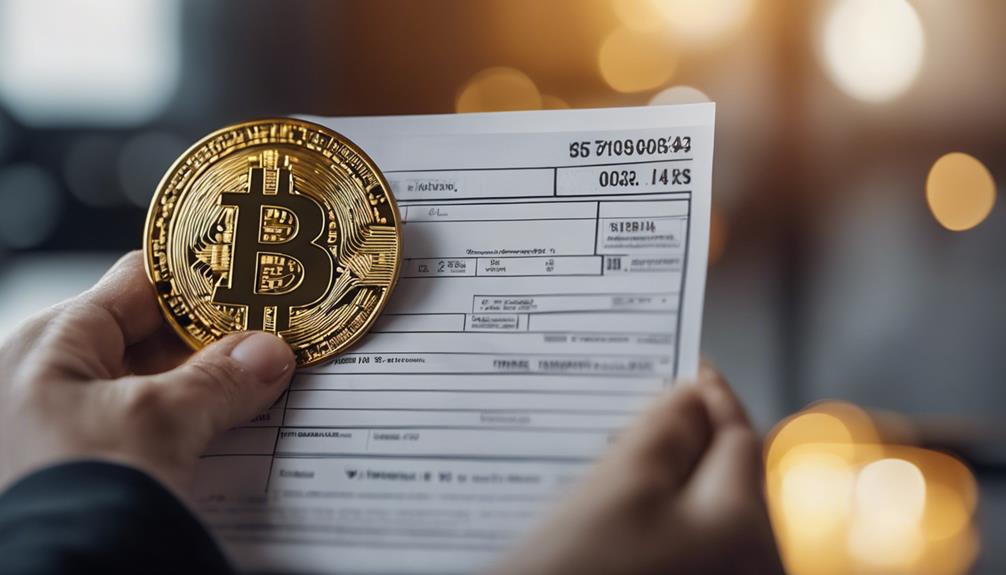
Exploring the tax benefits and diversification opportunities associated with Bitcoin IRAs reveals compelling advantages for retirement investors. When considering a Bitcoin IRA, individuals can benefit from:
- Tax Advantages: Bitcoin IRAs offer tax benefits similar to Traditional and Roth IRAs, providing the opportunity for tax-free growth and potential savings on capital gains. By investing in Bitcoin through a self-directed IRA, investors may reduce their tax burden and enhance their retirement savings.
- Diversification: Diversifying a retirement portfolio with Bitcoin can help mitigate risk and improve potential returns over the long term. Including digital assets like Bitcoin in a retirement account can offer a hedge against traditional market fluctuations, leading to a more balanced and diversified investment strategy.
- Risk Management: Bitcoin IRAs enable investors to enhance their risk management strategies by adding an alternative asset class to their retirement holdings. By incorporating Bitcoin into their portfolios, individuals can potentially reduce overall risk exposure and better protect their retirement savings against market volatility.
Managing Risks in the Cryptocurrency Market

In the dynamic world of the cryptocurrency market, effectively managing risks is paramount for investors seeking to navigate the complexities of digital assets. The volatile nature of the market, coupled with regulatory uncertainties, underscores the importance of implementing robust risk management strategies. Market unpredictability can lead to sudden fluctuations in the value of cryptocurrencies, highlighting the need for cautious investment decisions. Diversification plays a key role in mitigating risks associated with Bitcoin and other digital assets, spreading investment across various categories to reduce exposure to any single asset or market segment. Investors should stay informed about regulatory changes and market trends to adapt their strategies accordingly. By incorporating risk management techniques, such as setting stop-loss orders and utilizing secure custodian services like Bitcoin IRAs, investors can better safeguard their investments against potential market downturns and uncertainties.
| Key Risks | Risk Management Strategies |
|---|---|
| Market Volatility | Diversification |
| Regulatory Uncertainties | Stay Informed |
| Investment Fluctuations | Utilize Risk Management Tools |
Consultation and Decision-Making Process

Engaging a Bitcoin IRA custodian for consultation is a smart step towards thoroughly understanding the available options for securing digital assets in a retirement account. When going through the decision-making process in selecting a custodian, several key factors should be considered:
- Assessing Fees: Understanding the fee structure of different custodians is vital to make sure that costs align with your investment goals and financial strategy.
- Exploring Investment Options: Custodians offer various investment options, and evaluating these choices can help you tailor your portfolio to meet your long-term objectives effectively.
- Analyzing Tax Advantages, Risks, and Benefits: Delving into the tax advantages, risks, and benefits associated with Bitcoin IRAs is important for making informed decisions that align with your retirement planning and financial aspirations.
Frequently Asked Questions
Is Bitcoin IRA a Good Company?
Bitcoin IRA is a reputable company in the cryptocurrency IRA sector, founded in 2016. With support for over 60 cryptocurrencies and $700 million in insurance protection for digital assets, it offers a diverse range of investment options and enhanced security measures.
Simple setup processes and secure offline storage make it easy for individuals to invest in cryptocurrencies for retirement. Overall, Bitcoin IRA has established itself as a reliable option for those interested in digital asset investments.
Can I Withdraw Bitcoin From Bitcoin Ira?
While Bitcoin IRA custodians do not permit direct withdrawals of Bitcoin from the account, individuals can typically sell their Bitcoin holdings within the IRA and then withdraw funds in USD or other fiat currencies as mandated by IRS regulations.
It is important to follow proper procedures to avoid potential taxes and penalties. Consultation with a tax advisor or financial professional before initiating any withdrawals from a Bitcoin IRA is highly recommended to guarantee compliance and optimize financial outcomes.
Is Bitcoin IRA Insured?
Yes, Bitcoin IRAs are protected by reputable insurance providers like Bitcoin IRA and BitIRA. These insurance policies typically offer protection against hacking, theft, damage, and other risks associated with holding digital assets in a Bitcoin IRA.
Utilizing encryption technology and secure storage facilities, these custodians guarantee that investors' assets are safeguarded against external threats. This insurance coverage acts as a safety net, providing added security and peace of mind for individuals investing in Bitcoin IRAs.
How Does Bitcoin IRA Work?
Bitcoin IRAs provide individuals with a means to invest in cryptocurrencies like Bitcoin within a retirement account. These accounts operate similarly to traditional IRAs but offer the unique advantage of investing in digital assets.
Custodians oversee the management of investments within the IRA, ensuring the safekeeping of digital currencies. Through the custodian's platform, investors can buy and sell Bitcoin within the IRA structure, offering a way to diversify retirement portfolios beyond conventional stocks and bonds.
Conclusion
In summary, selecting a reputable Bitcoin IRA custodian is essential for securing your financial future.
Just as a ship needs a reliable captain to navigate through rough waters, choosing the right custodian can help steer your investments towards success.
With careful consideration of fees, tax benefits, and risk management strategies, you can take advantage of the opportunities presented by cryptocurrency while safeguarding your retirement savings.
Make informed decisions to protect and grow your wealth for the long term.
As our Lead Writer, Mia has a talent for turning complex ideas into compelling narratives. With a rich background in writing and a deep passion for psychology, Mia’s articles provide insightful, accessible explorations of narcissistic behavior and its impact on individuals and relationships. Mia’s contributions are thought-provoking and offer practical advice for our readers.
-

 How To Deal with Narcissism3 weeks ago
How To Deal with Narcissism3 weeks agoNarcissist Return Timeline: Factors & Predictions
-

 Covert Narcissist1 week ago
Covert Narcissist1 week agoThe Final Covert Narcissist Discard: Signs to Watch For
-

 Divorcing a Narcissist3 months ago
Divorcing a Narcissist3 months agoHealing Together: Support Groups for Narcissistic Abuse Survivors
-

 Covert Narcissist3 months ago
Covert Narcissist3 months ago10 Celebrities Who Display Covert Narcissist Behavior
-

 Narcissistic Cheating Patterns3 months ago
Narcissistic Cheating Patterns3 months agoUnveiling Habits: Cheating Narcissist at Home Post-Affair
-

 How To Deal with Narcissism4 weeks ago
How To Deal with Narcissism4 weeks agoOutsmarting a Narcissist in Court: Strategies to Beat Them
-

 Covert Narcissist1 week ago
Covert Narcissist1 week agoWhat Are the Signs of Covert Narcissist Stalking?
-

 How To Deal with Narcissism4 weeks ago
How To Deal with Narcissism4 weeks agoHow to Make a Narcissist Want You Sexually: A Step-by-Step Guide




